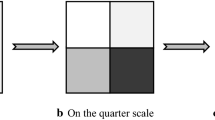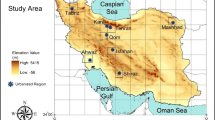Abstract
China is a large country with a population of 1.292 billion, accounting for 1/5 of the world population. However, the geographical distribution of population is greatly unbalanced. There are many factors contributing to the unbalanced population distribution, including natural condition, social and economic development, and transportation infrastructure. In this article, we specifically explore how natural factors (resource and geographical factors) influence the population distribution. We use the multiple linear regression to analyze how the county population and prefecture (districts under city administration) population density is influenced by different natural factors. The analysis is conducted at two scales: the national scale and the regional scale (including east region, northeast region, middle region and west region). Our results show that arable land proportion, precipitation, elevation, accumulated temperature (also called Effective Accumulated Temperature (EAT), means the sum of daily temperature for the period of daily mean temperature (Td) above 10°C) and the distance from energy distribution location, the distance from main rivers are the significant factors for all the counties in China. For the prefectures, the significant impacting factors include elevation, arable land proportion and distance from the main rivers. For the east region, elevation and arable land proportion are the significant impacting factors of population distribution. For the northeast region, arable land proportion, precipitation and accumulated temperature are the significant impacting factors. For the middle region, arable land proportion, accumulated temperature, distance from energy distribution location and elevation are the significant impacting factors. For the west region, arable land proportion, precipitation, distance from the main rivers, distance from energy distribution location and accumulated temperature are the significant impacting factors.





Similar content being viewed by others
References
An, J. (2004). Study on some laws of migration in ancient China. Geographical Research, 23(5), 667–676.
Beeson, P. E., DeJong, D. N., & Troesken, W. (2001). Population growth in U. S. counties, 1840–1990. Regional Science and Urban Economics, 31, 669–699.
Box, G. E. P., & Cox, D. R. (1964). An analysis of transformations. Journal of the Royal Statistical Society. Series B., 26, 211–246.
Dobson, J. E., Bright, E. A., Coleman, P. R., Durfee, R. C., & Worley, B. A. (2000). LandScan: A global population database for estimating populations at risk. Photogrammetric Engineering & Remote Sensing, 66(7), 849–857.
Fan, Z., & Côté, R. P. (1991). Population, development and marine pollution in China. Marine Policy, 5, 210–219.
Gu, B. (1996). Population, environment dynamics, poverty and quality of life in China. China Population Today, 13(5–6), 17–20.
Henderson, J. V. (1986). Efficiency of resource usage and city size. Journal of Urban Economics, 19(1), 47–70.
Hu, H. (1935). Distribution of China’s population. Acta Geographica Sinica, 2(2), 33–74.
Hu, H. (1982). An overview of the geographic distribution of the population in China. Renkou Yanjiu, 4, 25–29,46.
Hu, H. (1990). Population distribution, regionalization and prospects in China. Acta Geographica Sinica, 45(2), 139–145.
Hussain, A. (2002). Demographic transition in China and its implications. World Development, 30(10), 1823–1834.
Li, L. (2001). Internal population migration in China since the economic reforms: A review. Geographical Research, 4, 453–462.
Li, S. (2004). Population migration and urbanization in China: A comparative analysis of the 1990 population census and the 1995 national one percent sample population survey. International Migration Review, 38(2), 655–685.
Lin, G. C. S., & Ho, S. P. S. (2003). China’s land resources and land-use change: insights from the 1996 land survey. Land Use Policy, 20, 87–107.
Mera, K. (1977). The changing pattern of population distribution in Japan and its implications for developing countries. Habitat International, 2(5–6), 455–479.
NBSC (2004). National Bureau of Statistics of China. China Statistical Yearbook. Beijing: China Statistics Press.
Onoye, E. (1970). Regional distribution of urban population in China. Developing Economies, 8, 93–127.
Paarlberg, R. L. (1997). Feeding China: A confident view. Food Policy, 22(3), 269–279.
PCO (2003). Population Census Office under the State Council. Department of Population, Social, Sciense and Technology Statistics. Tabulations of the 2000 Census of China. Beijing: China Statistics Press.
Pimentel, D., Harman, R., Pacenza, M., Pecarsky, J., & Pimentelm, M. (1994). Natural resources and an optimum human-population. Population and Environment, 15(5), 347–369.
R (2005). Produced by: The R Development Core Team.
Riley, N. E. (2004). China’s population: New trends and challenges. Population Bulletin, 59(2), 1–36.
Rozelle, S., Huang, J., & Zhang., L. (1997). Poverty, population and environmental degradation in China. Food Policy, 22(3), 229–251.
SAS (2002–2003). Produced by: SAS Institute Inc. Cary, NC, USA.
Shen, J. (1996). Internal migration and regional population dynamics in China. Progress in Planning, 45(3), 123–188.
Shen, J. (1998). China’s future population and development challenges. The Geographical Journal, 164(1), 32–40.
Shen, J. (2000). Modelling national or regional grain supply and food balance in China. Environment and Planning A, 32, 539–557.
Shoshany, M., & Goldshleger, N. (2002). Land use and population density changes in Israel-1950 to 1990: Analysis of regional and local trends. Land Use policy, 19(2), 123–133.
Slater, P. B. (1993). World population distribution: Smoothed representations. Applied Mathematics and Computation, 53(2–3), 207–223.
Sun, J. (1982). Problems concerning population distribution in China. Renkou Yanjiu, (2), 10–11.
Tan, Y., & Wang, Y. (2004). Environmental migration and sustainable development in the upper reaches of the Yangtze River. Population and Environment, 25(6), 613–636.
Tian, Y., Chen, S., Yue, T., Zhu, L., Wang, Y., Fan, Z., & Ma, S. (2004). Simulation of Chinese population density based on land use. Acta Geographica Sinica, 59(2), 283–292.
Weeks, J. R. (2005). Population: An introduction to concepts and issues. Belmont, California: Wadsworth Publishing Company.
Weisberg, S. (2005). Applied linear regression. Hoboken, New Jersey: John Wiley and Sons, Inc.
Xu, C., & Gertner, G. (In press). Uncertainty and sensitivity analysis for models with correlated parameters. Reliability Engineering and System Safety.
Xu, J., & Yue, W. (2001). Evolvement and comparative analysis of the population center gravity and the economy gravity center in recent twenty years in China. Scientia Geographica Sinica, 21(5), 385–389.
Yang, Q., & Guo, F. (1996). Occupational attainments of rural to urban temporary economic migrants in China, 1985–1990. International Migration Review, 30(3), 771–787.
Yue, T., Wang, Y., Liu, J., Chen, S., Qiu, D., Deng, X., Liu, M., Tian, Y., & Su, B. (2005). Surface modelling of human population distribution in China. Ecological Modelling, 181(4), 461–478.
Zhang, S. (2003). Population Geography of China. Beijing: Science Press.
Zhang, K.H. & Song, S. (2003). Rural-urban migration and urbanization in China: Evidence from time-series and cross-section analysis. China Economic Review, 14(4), 386–400.
Zhu, C., Gu, C., Ma, R., Zhen, F., & Zhang, W. (2001). The influential factors and spatial distribution of floating population in China. Acta Geographica Sinica, 56(5), 549–559.
Zhu, Z. (1980). On the rational distribution of Chinese population. Renkou Yanjiu, (3), 11–17.
Zhu, Z. (1983). Tentative ideas on rationalization of population distribution in China. Population Research, 1(2), 28–34.
Zhuang, D., Liu, M., & Deng, X. (2002). Spatialization model of population based on dataset of land use and land cover change in China. Chinese Geographical Science, 12(2), 114–119.
Acknowledgements
This research is funded by the Key Projects of National Natural Science Foundation of China (No: 70433001).
Author information
Authors and Affiliations
Corresponding author
Rights and permissions
About this article
Cite this article
Chen, M., Xu, C. & Wang, R. Key natural impacting factors of China’s human population distribution. Popul Environ 28, 187–200 (2007). https://doi.org/10.1007/s11111-007-0041-x
Published:
Issue Date:
DOI: https://doi.org/10.1007/s11111-007-0041-x




